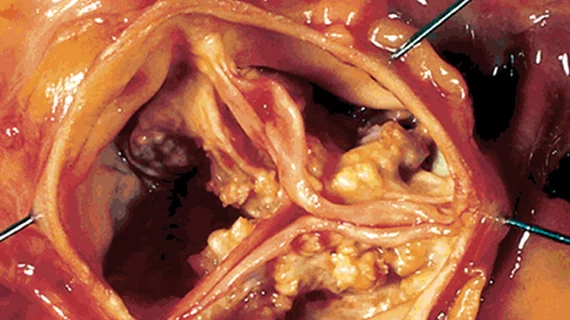Asymptomatic patients with severe aortic stenosis are at greater risk of all-cause and cardiovascular mortality if they have higher peak aortic jet velocities or left ventricular ejection fractions (LVEFs) below 60 percent, researchers reported Oct. 3 in JAMA Cardiology.
These findings point to the need for more frequent surveillance and possibly earlier aortic valve replacement (AVR) in patients with these characteristics, wrote lead author Patrizio Lancellotti, MD, PhD, with the Heart Valve Clinic at University of Liege Hospital in Belgium, and colleagues.
“The management of patients with asymptomatic severe AS, particularly the choice between early intervention (versus) watchful waiting, continues to be a matter of debate,” the authors wrote. “Current guidelines advocate delaying AVR until symptoms or left ventricular systolic dysfunction develop. However, observational studies … have suggested that early elective AVR might improve outcomes in patients with severe asymptomatic AS.”
To gain further insight into this issue, Lancellotti et al. studied 1,375 patients from 10 heart valve clinics in the U.S., Canada and Europe who had asymptomatic aortic stenosis (aortic valve area of 1.5 square centimeters or less) and LVEF greater than 50 percent at baseline.
The percentage of patients with severe stenosis who survived two and four years without AVR was 54 percent and 32 percent, respectively. AVR was performed in 45.1 percent of that cohort, with surgical AVR (79.9 percent) being selected most often over transcatheter AVR (TAVR).
Clinical characteristics like age, high cholesterol, chronic obstructive pulmonary disorder and hypertension were associated with all-cause mortality. Also, echocardiographic evidence revealed LVEF below 60 percent was associated with five times the risk of all-cause mortality and 4.5 times the risk of cardiovascular mortality. A peak aortic jet velocity of above 5 meters/second was linked to double the odds of all-cause mortality and more than six times the odds of cardiovascular death.
Lancellotti and colleagues noted the heightened risk tied to those characteristics remained even after successful valve replacement operations.
“These findings provide support for consideration of early elective AVR in these patients,” they wrote. “Closer and more frequent (every 6 to 12 months) clinical and echocardiographic follow-up might be implemented in patients with moderate AS and a peak aortic jet velocity of 3.0 m/s or greater or LVEF less than 60%.”
The researchers even mentioned the possibility of adjusting the cutoff for LVEF to less than 60 percent—rather than the current 50 percent—to define dysfunction and trigger the consideration of AVR for asymptomatic aortic stenosis.
“The occurrence of overt heart failure remains a significant problem even in heart valve centers of excellence,” Lancellotti and colleagues noted.
In an editors’ note, Patrick T. O’Gara, MD, and Robert O. Bonow, MD, agreed that “if validated in other studies, these observations could influence decision making and the timing of surgical referral.”
The editors pointed out a trial which is currently in the recruitment stage was designed to assess outcomes of patients with asymptomatic severe stenosis who are assigned to either early intervention with TAVR or active surveillance. However, that trial isn’t expected to report any results until 2021.
“In the interim, studies such as that reported by Lancellotti et al. will continue to shape our appreciation of this familiar but challenging disease,” Bonow and O’Gara wrote.

